#Celtic Reconstruction
Explore tagged Tumblr posts
Text
A start of shift prayer:
Gorfannon the Smith, guide my hand.
Amaethon of the Plough, give strength to my back.
Let me lose myself in my labours and find peace in my toil,
May my efforts be fruitful and my respite well earned.
#old gods#celtic gods#welsh mythology#welsh gods#ancient celts#celtic mythology#celtic#celtic reconstruction#mabinogi#mabinogion#paganism#pagan gods#pagan#celtic paganism#celtic polytheism#prayer#celtic pantheon
17 notes
·
View notes
Text
Bha mi a' leughadh postan gnàth mu "pàganachd Ghàidhlig/Cheilteach"- tha fios agaibh uile dè tha mi a' smaoineachadh mu dheidhinn - agus bha na daoine ag ràdh gu bheil tha iad ag ionnsachadh Gàidhlig a chionn 's gu bheil iad ag iarraidh "bruidhinn ris na seann diathan anns a' chànan a thuigeas iad". An uair sin bidh iad a' bruidhinn mu dhiathan a bha ann ron chòigeamh linn. Gu dearbh, bha crìonadh pàganachd mean air mhean, ach Gàidhlig? A charaidean, cha tuigeadh diathan pàganach 10 sa cheud den Ghàidhlig, agus tha mi glè fhialaidh
#Are you 'reconstructing' or simply using an amalgamation of history to suit a pseudo-scientific retelling#And denying a complete history of Christianity as an intrinsic part of Gaelic as per usual bc it doesn't fit the aesthetic/narrative#Reconstructionism always borders on rewriting doesn't it#Gàidhlig#Scottish Gaelic#Celtic
5 notes
·
View notes
Note
hello! if this is something you'd be comfortable sharing, what was your path to becoming a celtic reconstructionist pagan like? do you remember any resources that were particularly helpful? apologies if you've already talked about this somewhere else and I didn't notice!
hello, anon, and thank you for your ask!
i would like to add, first of all, that my experiences are mine only, and every pagan has different experiences when entering paganism for the first time
for me, i started to consider paganism mostly as a 'fuck you' to my community, which sounds pretty awful but hear me out. my family and local community is very christian, and i have had several bad experiences with christianity to the point at which i would describe it as religious trauma. i wanted to find a way out of christianity and started to search for a religion that suited me better.
at the same time, i was also struggling with what i would describe as a cultural void. i felt untethered, in a way, like i had no history, nothing to connect me to where i live or who i am. i began feverishly researching my scottish and irish roots. looking into celtic reconstructionism was the logical next step. at that point i had considered celtic paganism for a long time. i felt more connected to it than christianity or any other religion.
there are lots of different caveats of celtic paganism, but being a reconstructionist pagan appealed to me the most. like i said, i wanted some connection to my history, and worshipping in the same way my ancestors would have done seemed the most appealing to me. of course, some aspects of my worship are modern, or we have no evidence that they were practised in pre-roman britain.
as for resources, i really can't remember. if you're looking into reconstructionist paganism, first hand sources are a lifesaver. that is, if you can find any. records of how people actually worshipped two thousand years ago are limited, to say the least. also, there is quite a lot of misinformation on pagan sites about worship and gods: for example, cernunnos might be worshipped as a horned god by modern pagans, but he was not known as the 'horned god' by those who originally worshipped him. i mostly just scoured lots and lots of sites about celtic paganism, to be honest. i can't remember anything in particular, if anyone else has any resources feel free to add on!
4 notes
·
View notes
Video
youtube
You Don't Have to be Born in Ireland to Learn Irish Paganism - Lora O'Br...
I would really recommend this video. There is far too much racism in Irish pagan spaces, both overt and more insidious. I see so many Irish pagans on here (usually in NA but not exclusively) peddle disturbing ideas of DNA percentages and how this relates to Irishness. Ideas that cause direct harm to the black and brown people in Ireland.
Also touches on the American colonialist entitlement that is so prevalent here and the idea that evil Irish people are purposefully trying to gatekeep anything Irish. Irish people love sharing our culture, but having it decontextualised and reduced to caricatures is not sharing. It is appropriation, cultural appropriation. Please understand that this isn’t a random book or fandom this part of a culture that many people lived and died to keep, real people.
I think a lot of the anti-Irish resentment in Irish pagan spaces does come from a place of insecurity and I hope this video alleviates some of that insecurity, you have every right to practice but please do so respectfully.
(Standard disclaimer, Lora O'Brien is known for being condescending and short with people and is constantly trying to push her payed classes, which while good, are a matter of paying for convenience, all the information is already out there. This is just who she is as an individual, not a representation of every Irish person)
#irish reconstruct#gaelpol#irish paganism#gaelic paganism#celtic paganism#A really good video#besides from the shilling of her classes#which really arent vital#tbh use her resource guide and z library done#I really hope some people watch this video beacuse its really needed#irish revivalism
5 notes
·
View notes
Text
Can't wait to get my drivers license just so I can force people to listen to the music I like while I drive them around
0 notes
Text
I'd also add "people today don't actually know that folk religion is a thing," because there have always been popular religious practices that were not endorsed (and sometimes even explicitly disapproved of) by institutional churches but were carried out by people who would not have considered themselves anything but devout or at least conventional Christians. To an extent, of course, this could be seen as a subcategory of (1), although Protestants also engaged in folk religion and still do. (Puritans, for instance, very much framed Anglicans as basically pagan, and they basically invented the War on Christmas.) But at any rate, people often assume that everyone in the past was either a strict by-the-book version of whatever version of Christianity was dominant locally, or they were completely breaking with it either by being a heretic or a witch or a Secret Pagan, so if something isn't mentioned by an institutional church it must be either an act of rebellion against the church or something the church co-opted. Certainly none of the customs usually cited in this discourse go back far enough to be a product of the age when genuine syncretism was taking place.
For every claim about Pagan survivals in European / North American folk traditions and holidays, it's important to remember that there are at least three layers of cruft on top:
Sixteenth- and seventeenth-century Protestants trying to discredit Catholicism by claiming that it was secretly Pagan
Nineteenth-century Romanticists and Nationalists trying to construct an "authentic" volkisch identity by connecting everything to a remote pre-Christian (pre-Jewish) antiquity, and
Contemporary Neopagans and New Agers who want to maintain these traditions.
#also like#we know basically nothing about celtic and germanic paganism#which tend to be the ones that get mentioned in this conversation#see point (2) above for why that is#celtic in particular is very much a late modern reconstruction
10K notes
·
View notes
Text
The Stafford Road Man

Alright? You can call me Stafford Road Man. I was part of the earliest groups of Saxons to migrate to Britain after the fall of that pesky Roman Empire in around 500 CE. I lived longer than any of my other First Folks peers, dying at around 45. I had arthritis in my spine, shoulders, and hips, but was most likely a strong and powerful warrior back in my day! I was hit hard in the back on my leg, causing me to walk with a limp, and even had a broken rib that managed to heal. Nothing could keep me down! …Except maybe a bad tooth. I had a large abscess at the front of my mouth which, let me tell you, was unbelievably painful, and eventually gave me blood poisoning and killed me. Shame, innit?
#history#ancient history#anthropology#archaeology#sussex#east sussex#saxon#anglo saxon#reconstruction#wax work#wax figure#celtic#text#mine
1 note
·
View note
Text
If you don't know how old something is, it's also fun to just ... see the fog of history as a feature.
#sorry the post went around again about beliefs and how old they are. GRAND post#but I thought again how even if I put a lot of time into researching Ireland's ancient beliefs it's hard to reconstruct something#pre-christian. HOWEVER that is fun in the myth AU where Harry is a mortal king but also so clearly superpowered.#like we don't know if all heroes from ancient celtic stories are supposed to be gods but we can guess#but instead of giving a concrete answer about his divine nature let's just leave it up in the air and make him ridiculously gifted#Paddy? Giant. Charlie? Changeling. Harry and Soph? Human ...????? Who knows. The mystery is the spice ~#but also the myth AU goes from fuck me 700 BCE to 1200 AD. Idk the timeline in that bitch everyone is just co-existing#beablabbers
0 notes
Text
Womens history just got richer.

When the deeply patriarchal Romans first encountered Celtic tribes living in modern-day France and Great Britain in the first century B.C.E., their reaction to the roles of the sexes was one of surprise and dismay. The tasks of men and women “have been exchanged, in a manner opposite to what obtains among us,” wrote one Roman historian.
New evidence from Celtic graves now confirms that at least one part of Britain was a woman’s world long before the Romans arrived—and for centuries afterward. One ancient British tribe known as the Durotriges based its family structure—and perhaps property inheritance—on kinship between mothers and daughters. Men, meanwhile, left home to live with their wives’ families, a practice known as matrilocality that has never been seen before in European prehistory.
The work, published today in Nature, helps explain why women in Iron Age Britain are often buried with high-status grave goods such as mirrors and even chariots, says Ludwig Maximilian University of Munich archaeologist Carola Metzner-Nebelsick, who was not involved with the research. “It’s a fantastic result,” she says. “It really helps explain the archaeological record.”
Ancient histories—not least Julius Caesar’s 50 B.C.E. account of invading Gaul—hinted at female empowerment among the Celts. “They wrote about it because they found it so weird,” says Trinity College Dublin geneticist Lara Cassidy.
Many modern historians assumed the accounts were exaggerated; they dismissed rich female graves from the time as outliers. But over the past few decades, archaeologists comparing burial practices at hundreds of Iron Age sites from Britain to Germany began to think there was a kernel of truth to the Roman reports.
The Durotriges cemeteries, located in the far south of England near the city of Bournemouth, offered a way for Cassidy and her team to investigate. Burials there began around 100 B.C.E., roughly 150 years before Roman forces invaded the island. Unusually for Iron Age Britain, the tribe didn’t cremate their dead. Instead they buried them close to home, in the hills surrounding their farmsteads.
Whereas men were laid to rest with a joint of meat and perhaps a pot containing a beverage to sustain them on their journey into the afterlife, Durotriges women are often found with elaborate offerings including mirrors, combs, jewelry, and even swords. “If you judge social status by burial goods, then female burials have vastly more than male,” says Bournemouth University archaeologist Miles Russell, a co-author of the new paper.
Over the past 4 years, researchers sequenced DNA from dozens of Durotriges skeletons in a set of cemeteries in Dorset, England. By matching identical fragments of genetic material from different individuals, they reconstructed a family tree that spanned six generations—many of whom were female descendants of a single female founder. Two-thirds of the people in the kin group buried in the cemetery shared a rare type of mitochondrial gene, a form of DNA inherited only from the mother, including some of the men who shared the same female ancestor.
Other genetic evidence from the Durotriges cemeteries pointed to matrilocality, showing that men joined the clan from other families. “Women are staying close to family and are embedded in the support network they’ve known since childhood,” Cassidy notes. “It’s the husband who’s coming in as a stranger and is dependent on the wife’s family.” Women were evidently a force to be reckoned with in this part of Iron Age Britain.

Archaeologists have found that members of Great Britain’s Durotriges tribe often buried women with more grave goods than men.Miles Russell/Bournemouth University
Such patterns could help explain finds elsewhere in the Celtic world, where women were sometimes buried with rich grave goods or even chariots. “We’re thinking this could have been quite widespread,” Cassidy says.
To gather further evidence, she and her colleagues re-examined previously published genomes from more than 150 sites in Britain and Europe stretching back to the Stone Age. Starting around 500 B.C.E., the diversity in people’s mitochondrial DNA declined, the team found, suggesting more of them shared the same female ancestors. There was no matching decline in the diversity of Y chromosomes, which are passed from fathers to sons.
That suggests communities across Britain were anchored by specific female lines, with men marrying in from outside. “The signal they see in [the Durotriges] case study can be reproduced in other British sites,” says Max Planck Institute for Evolutionary Anthropology archaeogeneticist Joscha Gretzinger, who was not involved with the work. “That’s quite a smoking gun.”
The study is part of a growing use of DNA to reconstruct genetic kinship in the deep past—and use it to shed light on the structure of past societies. University of Liverpool archaeologist Rachel Pope says the research is starting to highlight the wide variety of social organization people practiced in the past, something archaeology has hinted at over the past 2 decades.
Some of the earliest kinship studies using ancient DNA, for example, showed that Stone Age farmers in Britain and France living in the fifth millennium B.C.E. were organized patrilocally, with women leaving their homes to marry while men stayed put. The new data from Durotriges suggest that by the Iron Age, 4000 years later, something had shifted. “This is quite exciting,” Pope says. “There are moments in time in which societies seem to have a lot of high female status.”
#Women in history#ancient britain#ancient British tribe known as the Durotrig#matrilocality#Bournemouth
153 notes
·
View notes
Note
I feel like just with any other tradition it's decided by historical precedent and especially the People, (if its based in ethnic supremacy its another story but ignoring that for now)
As an example, Mari faith. It survived Christianization to a high degree, was influenced but not replaced by it, was syncretized with it, or are practiced side by side. While there is a neo-pagan like revival I feel as if the Mari people get the final say. Same with Udmurt faith, while not as well preserved as Mari, it still heavily exists among their communities; it never died. It also has a neo-pagan like revival that exists but I believe Udmurt people get the final say. These faiths were persecuted by the Russian Empire, USSR state atheism, and now a further push of Russification in the Russian Federation.
Both of these are European. Both are living cultures and living folk traditions. I don't have the answer as to whether they are closed or opened. It might be extremely difficult to discuss the topic with an Udmurt person or Mari person without knowing Russian. I could be wrong on that last part and simply have not come across them online yet to discuss their culture. However, I'd encourage people who want to participate in those folk religions/cultures that have no ancestral ties: talk to the people. If you REALLY want to participate make an effort to talk to them.
Compare this to Greece. The ancient religion was open— we know this as a fact (Exhibit A: Alexander The Great. Exhibit B: interpretatio Graeca. Exhibit C: Serapis). I've discussed with many Greeks that modern Hellenic Polytheistic/Pagan Religion is open, if you respect Greek culture and are aware that Greeks still exist. That Hellenic Religion never vanished completely, it is still apart of Greek culture. I have also discussed this with a Hellenic Polytheist organization from Greece who said that it is open. (As opposed to a very ethno-nationalistic form of "Greece is for Greeks" type organization that attempts to talk for all Hellenic polytheists that live in Greece.) As a Greek American I have literally no issue with non-Greek people being Hellenic Polytheists: except when I see them forgetting Greek people still exist or completely disregarding culture as if it doesn't matter. (Literally saw a non-Greek Canadian claim Hellenic Polytheism wasn't Greeks' heritage and they had no claim to "Hellene" because they "gave it up" when they became Christian wtf)
Another example is Celtic Polytheism: Irish, Cornish, Manx, Breton, Scottish, and Welsh are all different cultures— "Celtic Nations". I have seen quite a lot of people from these cultures being frustrated about how all deities, traditions, stories are melded into a pan-Celtic pantheon & tradition without even an attempt to learn the separations. Refusal or lack of interest in learning differences in festivals, cultures, histories, or languages. I've never seen them call it closed, only that they want the different nations/cultures to be respected and at least have an understanding that differences exist. Also that the languages, cultures, and people still exist.
I don't have personal experience reading a lot of Slavic Polytheist opinions on here. But there are MANY ethnicities/nations that are "Slavic" and I imagine, just like Celts, they would prefer their differences be recognized and respected.
In addition, immigration within Europe from an ethnicities' traditional homeland to another location within Europe (including unfortunate forced relocation). They may have brought their folk traditions with them, adopted the surrounding culture's ones, or mixed them! AND the many immigrants who came from outside Europe. They may have also brought their own traditions with them, adopted the ones in the place they settled in, or have mixed them together.
Not only that, ethnicity & nationality, is much more than blood. Culture, upbringing, language(s), location, music, cuisine, traditional dress, history, religion etc etc etc is often considered what defines the ethnicity, culture, and its folk traditions; more so than blood or skin tone. This would include ethnic & local folk religions and traditions. I'll use myself as an example, (other then ethnic supremacists), I've known many Greeks, both in the diaspora and in Greece, that consider me a Greek American due to my upbringing and passed on heritage, not because of my adoptive mother's blood/genetics.
I could go on and on. The number of "Sovereign Nation States" in Europe in no way shape or form reflects the diversity of ethnicities in Europe— have you ever heard of the Karelians, Wallons, Rusyns, Sorbs (Lusatians), Izhorians, Sami, Faroe Islanders etc?
I think its a silly question because its so broad— Ask. The. People.
Europe is extremely ethnically, racially, and linguistically diverse. More than we give it credit for.
---
I have a whole draft about "dead religion" appropriation and open/closed that would seem excellent here but I've been too worried & scared to edit and post.
-Dyslexia: did my best to audio proof read for once-
What’s your stance on white Americans appropriating local European folk traditions? Does this count as cultural appropriation? Or is it Volkist to say so?
Your question appears to frame Europeans as if they're all white and culturally monolithic/interchangeable.
#also afraid to post this#cultural appropriation#reblogresponse#steppingontoes#ofthetheoi#europe#ethnicities in europe are more numerous than youd think#like just look at the traditional folk dress differences from different areas of the modern Hellenic Republic#also why do i have a desire to like learn every language#obviously spanish and greek make sense#but why Udmurt?#like why do I have a desire for that?#lets be real i just love languages and endangered languages hurt my heart#knowing theyll survive warms my heart#fuck yes to all revitalization preservation and reconstruction language programs out there#greek#celtic#slavic#udmurt#mari#scottish#irish#welsh#cornish#manx#breton#polytheism#folk traditions#folk religion#ethnicity
126 notes
·
View notes
Text

So I got this tag on my answer to an ask about when it became acceptable for western women to wear pants, and you know it's all I need to go on a tangent.
I think the short answer here would be men have worn skirts as long as people have worn anything, so pretty long tbh. But since I am incapable of answering anything shortly, I think we can re-frame this question:
When did skirts stop being socially acceptable for men?
So let's start with acknowledging that tunics, togas, kirtles and such men wore through history were, in fact, skirts. I think there's often a tendency to think of these as very different garments from those that women wore, but really they are not. Most of the time they were literally referred to with the same name. (I will do a very broad and simplified overview of men's clothing from ancient times to Early Middle Ages so we can get to the point which is Late Middle Ages.)
Ancient Greek men and women both wore chitons. Even it's length wasn't determined by gender, but by occupation. Athletes, soldiers and slaves wore knee-length chitons for easier movement. Roman men and women wore very similar garment, tunics. Especially in earlier ancient Rome long sleeves were associated with women, but later became more popular and unconventional for men too. Length though was still dependent on occupation and class, not gender. Toga was sure men's clothing, but worn over tunic. It was wrapped around the waist, like a dress would, and then hung over shoulder. Romans did wear leggings when they needed to. For example for leg protection when hunting as in this mosaic from 4th century. They would have been mostly used by men since men would be doing the kinds of activities that would require them. But that does not lessen the dressyness of the tunics worn here. If a woman today wears leggings under her skirt, the skirt doesn't suddenly become not a skirt.
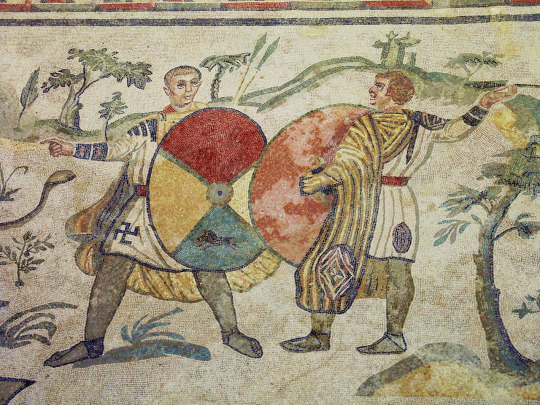
All over Europe thorough the early Middle Ages, the clothes were very similar in their basic shape and construction as in Rome and Greece. In Central and Northern Europe though people would wear pants under shorter tunics. There were exceptions to the everyone wearing a tunic trend. Celtic men wore braccae, which were pants, and short tunics and literally just shirts. Celts are the rare case, where I think we can say that men didn't wear dresses. Most other peoples in these colder areas wore at least knee-length tunics. Shorter tunics and trousers were worn again mostly by soldiers and slaves, so rarely any other woman than slave women. The trousers were though definitely trousers in Early Middle Ages. They were usually loose for easier construction and therefore not that similar to Roman leggings. However leggings style fitted pants were still used, especially by nobility. I'd say the loose trousers are a gray area. They wore both dresses and pants, but still definitely dresses. I'd say this style was very comparable to the 2000s miniskirts over jeans style. First one below is a reconstruction of Old Norse clothing by Danish history museum. The second is some celebrity from 2005. I see no difference.
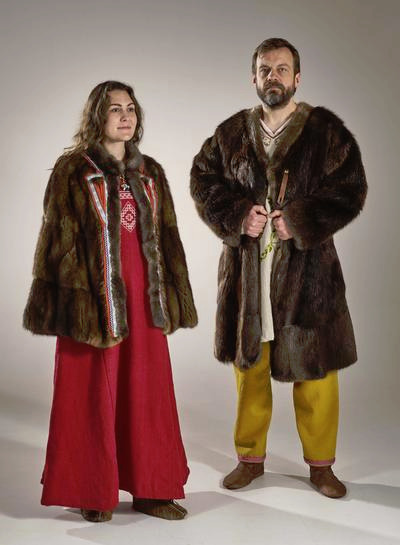

When we get to the high Middle Ages tunics are still used by both men and women, and still it's length is dependent on class and activity more than gender, but there's some new developments too. Pants and skirt combo is fully out and leggings' are back in in form of hose. Hose were not in fact pants and calling them leggings is also misleading. Really they are socks. Or at least that's how they started. As it has become a trend here they were used by everyone, not just men. During early Middle Ages they were worn often with the trousers, sometimes the trousers tucked inside them making them baggy. In high Middle Ages they became very long when used with shorter tunics, fully displacing the need for trousers. They would be tied to the waist to keep them up, as they were not knitted (knitting was being invented in Egypt around this time, and some knitting was introduced to Europe during middle Ages, but it really only took off much later during Renaissance Era) and therefore not stretchy. First picture is an example of that from 1440s. Another exciting development in the High Medieval era was bliaut in France and it's sphere of influence. Bliaut was an early attempt in Europe of a fitted dress. And again used by both men and women. The second illustration below from mid 12th century shows a noble man wearing a bliaut and nicely showing off his leg covered in fitted hose. Bliaut was usually likely fitted with lacing on the sides, but it wasn't tailored (tailoring wasn't really a thing just yet) and so created a wrinkled effect around the torso.
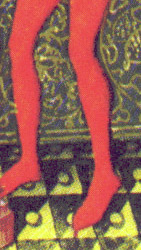

In the 14th century things really picked up in European fashion. European kingdoms finally started to become richer and the rich started to have some extra money to put into clothing, so new trends started to pop up rapidly. Tailoring became a thing and clothes could be now cut to be very fitted, which gave birth to fitted kirtle. At the same time having extra money meant being able to spend extra money on more fabric and to create very voluminous clothing, which gave birth to the houppelande.
Kirtle was once again worn by everyone. It wasn't an undergarment, for women that would be shift and men shirt and breeches, but it was an underlayer. It could be worn in public but often had at least another layer on top of it. The bodice part, including sleeves were very fitted with lacing or buttons (though there were over-layer kirtles that had different sleeves that changed with fashions and would be usually worn over a fitted kirtle). Men's kirtles were short, earlier in 14th century knee-length but towards the end of the century even shorter styles became fashionable in some areas. First picture below shows a man with knee-length kirtle from 1450s Italy.
Houppelande was also unisex. It was a loose full-length overgown with a lot of fabric that was gathered on the neckline and could be worn belted or unbelted. The sleeves were also wide and became increasingly wider (for men and women) later in the century and into the next century. Shorter gowns similar in style and construction to the houppelande were also fashionable for men. Both of these styles are seen in the second picture below from late 14th century.
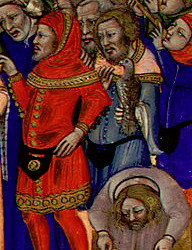

In the very end of 14th century, first signs of pantification of men can be seen. In France and it's sphere of influence the skirt part of the kirtle became so short it barely covered the breeches as seen below on these fashionable musicians from 1395-1400 France. Long houppelandes, length ranging from floor to calf, were still used by men though (the second picture, 1414 France), as were knee and thigh length gowns of similar loose style.

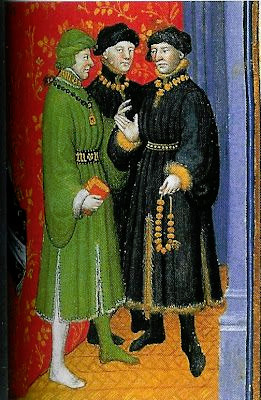
The hems continued to be short through the 15th century in France, but in other places like Italy and German sphere of influence, they were still fairly long, at least to mid thigh, through the first half of the century. In France at some point in late 13th century the very short under-kirtle started to be called doublet and they are just getting shorter in 1400s. The showing underwear problem was fixed by joined hose and the codpiece, signaling the entrance of The Sluttiest Era of men's fashion. Below is an example from 1450s Belgium of doublet and early codpiece in display. As you can see from the other figures, the overgowns of the previous century were also getting very, very short. In the next French example below from 1470s we can see the skirt shrink out of existence right before our eyes.
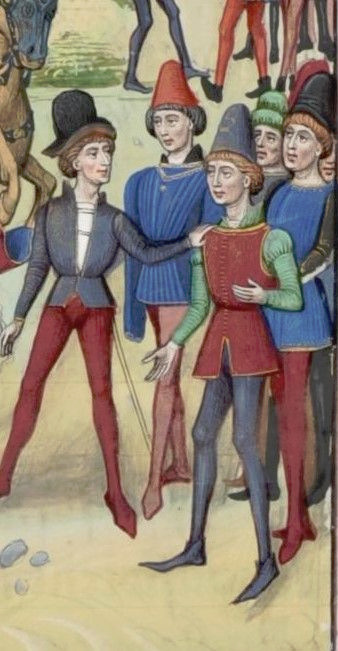

The very skimpy doublet and it's accompanying codpiece spread to the rest of the Europe in the second half of 15th century and it would only get sluttier from there. The Italians were just showing their full ass (example from 1490s). The dress was not gone yet though. The doublet and codpiece continued to be fashionable, but the overdress got longer again in the French area too. For example in the second example there's Italian soldiers in a knee length dresses from 1513.
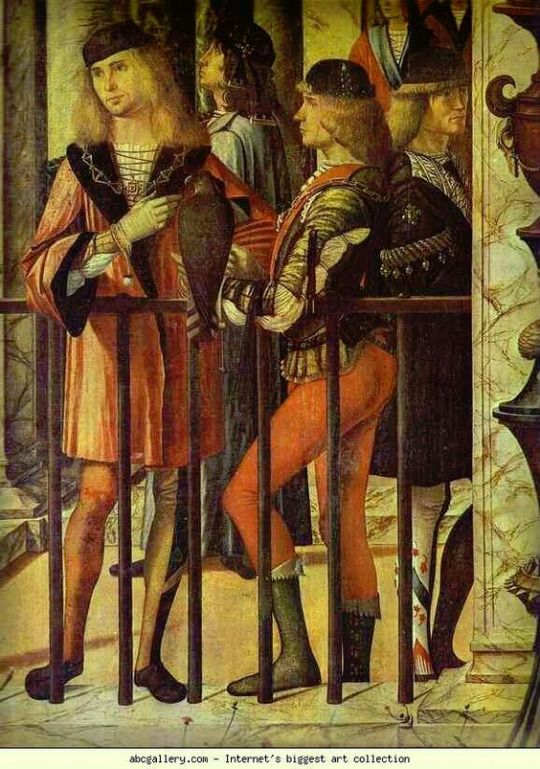
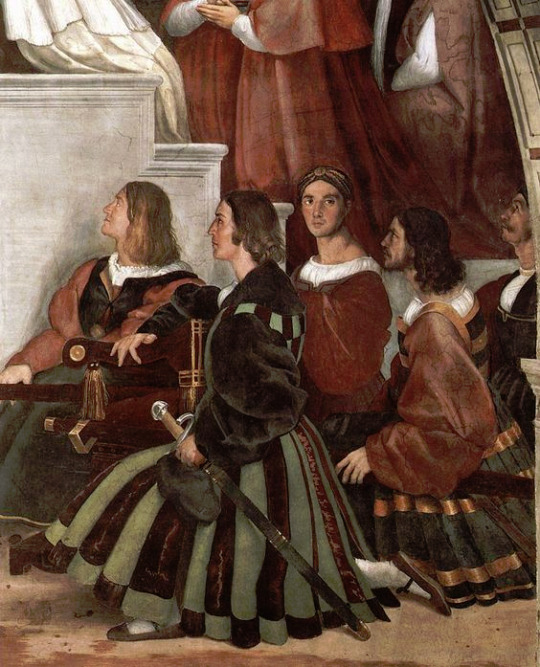
But we have to talk about the Germans. They went absolutely mad with the whole doublet and codpiece. Just look at this 1513 painting below (first one). But they did not only do it sluttier than everyone else, they also changed the course of men's fashion.
Let's take a detour talking about the Landsknecht, the mercenary pikeman army of the Holy Roman Empire. (I'm not that knowledgeable in war history so take my war history explanation with a grain of salt.) Pikemen had recently become a formidable counter-unit against cavalry, which earlier in the Medieval Era had been the most important units. Knights were the professional highly trained cavalry, which the whole feudal system leaned against. On the other hand land units were usually not made of professional soldiers. Landsknecht were formed in late 15th century as a professional army of pikemen. They were skilled and highly organized, and quickly became a decisive force in European wars. Their military significance gave them a lot of power in the Holy Roman Empire, some were even given knighthood, which previously wasn't possible for land units, and interestingly for us they were exempt from sumptuary laws. Sumptuary laws controlled who could wear what. As the bourgeois became richer in Europe in late Middle Ages and Renaissance Era, laws were enacted to limit certain fabrics, colors and styles from those outside nobility, to uphold the hierarchy between rich bourgeois and the nobles. The Landsknecht, who were well payed mercenaries (they would mutiny, if they didn't get payed enough), went immediately absolute mad with the power to bypass sumptuary laws. Crimes against fashion (affectionate) were committed. What do you do, when you have extra money and one of your privileges is to wear every color and fabric? You wear every color and fabric. At the same time. You wear them on top of each other and so they can be seen at the same time, you slash the outer layer. In the second image you can feast your eyes on the Landsknecht.


Just to give you a little more of that good stuff, here's a selection of some of my favorite Landsknecht illustrations. This is the peak male performance. Look at those codpieces. Look at those bare legs. The tiny shorts. And savor them.
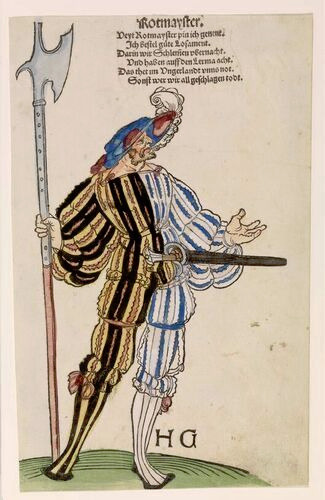
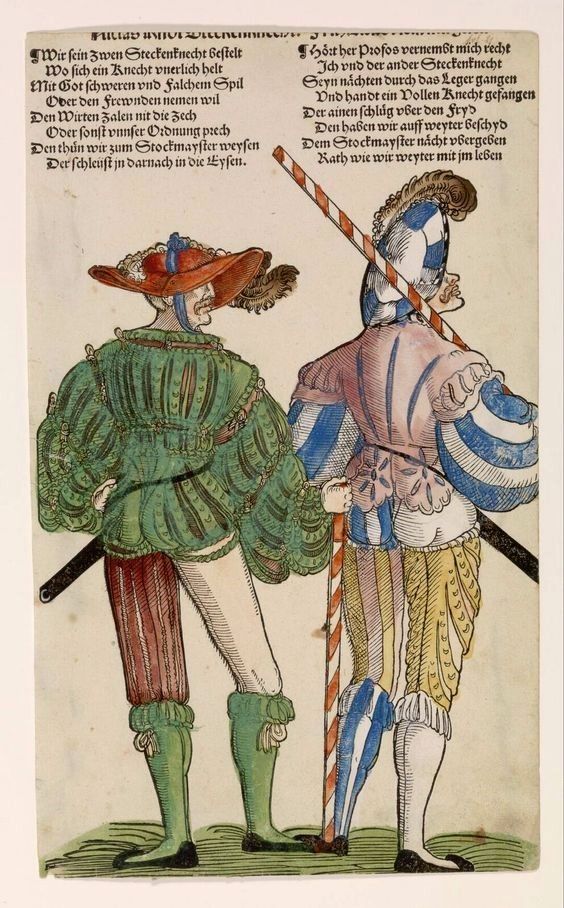
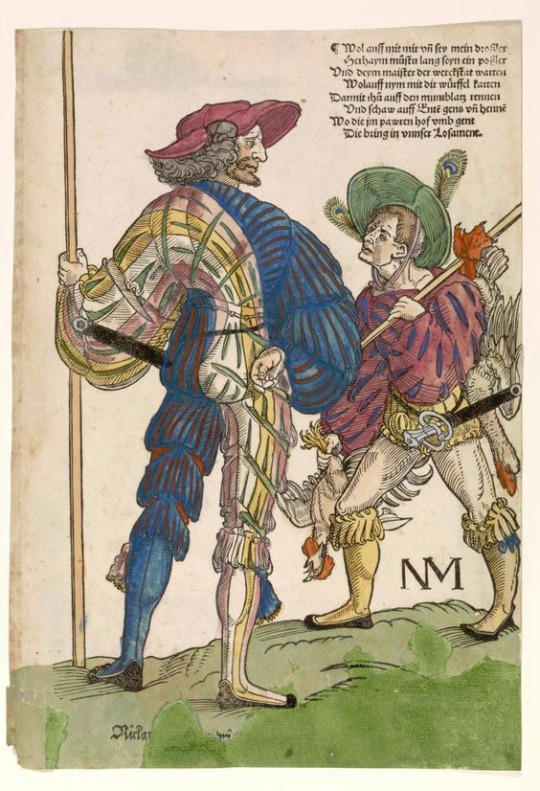
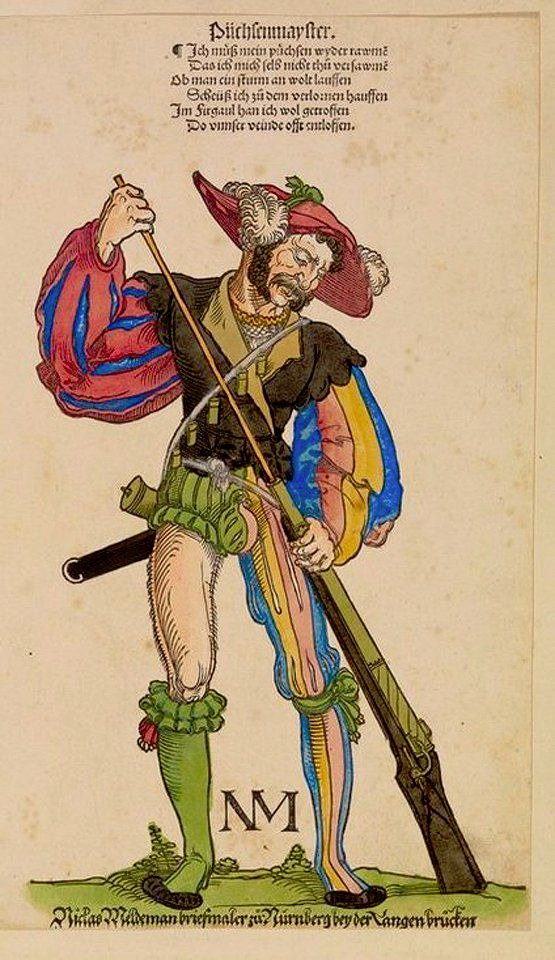
The Landsknecht were the hot shit. Their lavish and over the top influence quickly took over men's fashion in Germany in early 1500s. Slashing, the technique possibly started by them, but at least popularized by them, instantly spread all over Europe. That's how you get the typical Renaissance poof sleeves. They at first slashed the thighs of their hose, but it seems like to fit more of everything into their outfits, they started wearing the hose in two parts, upper hose and nether hose, which was a sort of return to the early Medieval trousers and knee-high hose style. The two part hose was adopted by the wider German men's fashion early in the century, but already in 1520s had spread to rest of Europe. It was first combined with the knee-length overdress that had made it's comeback in the turn of the century, like in this Italian painting from 1526 (first image). At this point knitting had become established and wide-spread craft in Europe and the stockings were born, replacing nether hose. They were basically nether hose, but from knitted fabric. The gown shortened again and turned into more of a jacket as the trunk hose became increasingly the centerpiece of the outfit, until in 1560s doublet - trunk hose combination emerged as the standard outerwear (as seen in the second example, 1569 Netherlands) putting the last nail on the coffin of the men's dress as well as the Sluttiest Era. The hose and doublet became profoundly un-slutty and un-horny, especially when the solemn Spanish influence spread all over with it's dark and muted colors.


Especially in Middle Ages, but thorough European history, trousers have been associated with soldiers. The largely accepted theory is that trousers were invented for horse riding, but in climates with cold winters, where short skirts are too cold, and long skirts are still a hazard when moving around, trousers (with or without a short skirt) are convenient for all kinds of other movement requiring activities like war. So by adopting hose as general men's clothing, men in 1500s associated masculinity with militarism. It was not a coincidence that the style came from Landsknecht. I may have been joking about them being "peak male performance", but really they were the new masculine ideals for the new age. At the time capitalism was taking form and European great powers had begun the process of violently conquering the world for money, so it's not surprising that the men, who fought for money and became rich and powerful doing so, were idealised.
Because of capitalism and increasingly centralized power, the feudal system was crumbling and with it the feudal social hierarchy. Capitalism shifted the wealth from land ownership (which feudal nobility was built upon) to capital and trade, deteriorating the hierarchy based on land. At the same time Reformation and centralized secular powers were weakening the power of the Church, wavering also the hierarchy justified by godly ordain. The ruling class was not about to give up their power, so a new social hierarchy needed to form. Through colonialism the concept of race was created and the new hierarchy was drawn from racial, gender and wealth lines. It was a long process, but it started in 1500s, and the increasing distinction between men's and women's fashions was part of drawing those lines. At the same time distinctions between white men and racialized men, as well as white women and racialized women were drawn. As in Europe up until this point, all over the world (with some exceptions) skirts were used by everyone. So when European men fully adopted the trousers, and trousers, as well as their association to military, were equated with masculinity, part of it was to emasculate racialized men, to draw distinctions.
Surprise, it was colonialism all along! Honestly if there's a societal or cultural change after Middle Ages, a good guess for the reason behind it is always colonialism. It won't be right every time, but quite a lot of times. Trousers as a concept is of course not related to colonialism, but the idea that trousers equal masculinity and especially the idea that skirts equal femininity are. So I guess decolonize masculinity by wearing skirts?
#this has been sitting in my drafts almost finished for like a year or something#historical fashion#fashion history#fashion#history#dress history#men's historical fashion#renaissance fashion#medieval fashion#western fashion#western fashion history#landsknecht
3K notes
·
View notes
Photo

England & Wales place-names rendered into High German (morphologically reconstructed with attention to ultimate etymology and sound evolution processes)
to try to reconstruct a 'plausible'-sounding german version of names, it was hard to decide whether to go right back to a shared proto-indo european root (as with Hagen- in Cardiff etc.), or to simply conjecture what may have become of a celtic name in german (as with Carlisle).
in order to try and keep it realistic the gazetteer of german place names was open in front of me, so that i could find actual attestation (in germany & austria) for most of the (parts of the) names on this map, even with shared etymologies.
Gottverdammt! stupid mistakes found: Yorch(scheier) should of course be **J****orch, Nordfolk should be Nord****v****olk, Marken should be Gemarken
by topherette
206 notes
·
View notes
Text

I’ll keep the king when you are gone away. I’ll keep him safe from the dark things that wait. — King by The Amazing Devil
INPRNT | COMMISSION INFOS
-
Some details for archaeology nerds (Here we go again AHAHAHA)
First of all the costume Alfred wears in this pic is BY NO MEANS historical accurate, but if we really want to be 100% accurate then to my knowledge there’s a high chance that Alfred wouldn’t be wearing dresses gowns at all (whoever decided to make Alfred wear those pretty cough dresses cough in the show I wish your family to prosper for all eternity YOU’RE A HERO), so instead I just chose to design whatever clothes I want and add some Anglo-Saxon elements in it :)
1. Alfred’s earrings
Took inspiration from the 7th century Anglo-Saxon/Frankish crystal ball, now in Ashmolean Museum, Oxford. Here’s the thing, I know English men (and the monarchs) don’t wear earrings until the 16th century and earrings weren’t even popular during the Anglo-Saxon period, but once I saw Charles I wearing pearl earrings in his portrait I just can’t help but put something pretty on Alfred’s ears as well lol…Sadly I can’t find the exact size of this one but the official site says that it was used as a pendant/an amulet! Probably for pagan practices though, but it’s pretty, isn’t it? :D


2. Patterns on Alfred’s gown
Taken from the patterns on the Bewcastle Cross in Cumbria (which used to belong to Northumbria, built in around the 7th to early 8th century, aka the period Bede lived in.


3. The woven band
The pattern is taken from the Laceby band found in Laceby, Lincolnshire, dated to early 7th century. It seems both Scandinavians and Anglo-Saxons enjoy wearing tablet-woven bands? Saw this kind of things a lot in viking clothes reconstruction as well.


4. …Whatever this is
From fol. 34r in Book of Kells, the famous Celtic gospel book completed in Ireland circa 800 AD. As you can see I got lazy during drawing this lol but the illustrations in the original manuscripts are really impressive!


Now I don’t know if this is a good news or not but I’ve still got like…six wips for alhtred in hand…Good god of arts DELIVER ME
#posting it before i start wanting to kill myself#this was supposed to be a doodle but in the end i spent 30 hours on it and it still looks like shit#urghhhh#sometimes i hate doing arts lol#ok sorry for artist’s rants#SO about the drawing itself#this is completely a self indulgent piece LOL#at the end of the day i just want to make alfred wear pretty things :3#and see him being bridal carried#that’s all lol#BTW can we just ignore for a second how strong uhtred would need to be in order to carry alfred like that by one single hand#we call it ✨creative freedom✨#p.s. I’m thinking the when ‘you’ are gone away quote is Uhtred referring to the christian god lol#the last kingdom#tlk alfred#alfred x uhtred#uhtred x alfred#king alfred#alfred the great#alhtred#uhtred#hikaruchen#hikaru tlk
141 notes
·
View notes
Text
The gods of Gaul: Introduction, or why it is so hard to find anything
As I announced, I open today a series of post covering what some can call the "Gaulish mythology": the gods and deities of Ancient Gaul. (Personal decision, I will try avoiding using the English adjective "Gaulish" because... I just do not like it. It sounds wrong. In French we have the adjectif "Gaulois" but "Gaulish"... sounds like ghoulish or garrish, no thank you. I'll use "of Gaul", much more poetic)
[EDIT: I have just found out one can use "Gallic" as a legitimate adjective in English and I am so happy because I much prefer this word to "Gaulish", so I'll be using Gallic from now on!]
If you are French, you are bound to have heard of them one way or another. Sure, we got the Greek and Roman gods coming from the South and covering up the land in temples and statues ; and sure we had some Germanic deities walking over the rivers and mountains from the North-East to leave holiday traditions and folk-beliefs... But the oldest gods of France, the true Antiquity of France, was Gaul. And then the Roman Gaul, and that's already where the problems start.
The mythology of Gaul is one of the various branches of the wide group known as Celtic mythology or Celtic gods. When it comes to Celtic deities, the most famous are those of the British Isles, due to being much more preserved (though heavily Christianized) - the gods of Ireland and the Welsh gods are typically the gods every know about when talking about Celtic deities. But there were Celts on the mainland, continental Celts - and Gaul was one of the most important group of continental Celts. So were their gods.
Then... why does nobody know anything about them?
This is what this introduction is about: how hard it actually is to reconstruct the religion of Gaul and understand its gods. Heck we can't ACTUALLY speak of a Gaulish mythology because... we have no myth! We have not preserved any full myth or complete legend from Ancient Gaul. The pantheon of Gaul is the Celtic pantheon we probably know the least about...
Why? A few reasons.
Reason number one, and the most important: We have no record of what the Gauls believed. Or almost none. Because the people of Gaul did not write their religion.
This is the biggest obstacle in the research for the gods of Gaul. It was known that the art of writing was, in the society of Gaul, an elite art that was not for the common folks and used only for very important occasions. The druids were the ones who knew how to read and write, and they kept this prerogative - it was something the upper-class (nobility, rulers) could know, but not always. Writing was considered something powerful, sacred and magical not to be used recklessly or carelessly. As a result, the culture of Gaul was a heavily oral one, and their religion and myths were preserved in an oral fashion. Resulting in a great lack of written sources comng directly from the Gallic tribes... We do have written and engraved fragments, but they are pieces of a puzzle we need to reconstruct. We have votive offerings with prayers and demands inscribed on it - and while they can give us the names of some deities, they don't explain much about them. We have sculptures and visual representations of the deities on pillars and cups and jewels and cauldrons - but they are just visuals and symbols without names. We have calendars - but again, these are just fragments. We have names and images, and we need to make sense out of it all.
To try to find the explanations behind these fragments, comparisons to other Celtic religions and mythologies are of course needed - since they are all branches of a same tree. The same way Germanic mythology can be understood by looking at the Norse one, the same way Etruscan, Greek and Roman mythologies answer each other, the mythology and religion of Gaul has echoes with the Celtic deities of the Isles (though staying quite different from each other). The other comparison needed to put things back into context is reason number 2...
Reason number two: The Romans were there.
Everybody knows that the death of Ancient Gaul was the Roman Empire. Every French student learns the date of Alesia, the battle that symbolized the Roman victory over the Gallic forces. Gaul was conquered by the Romans and became one of the most famous and important provinces of the Roman Empire: it was the Gallo-Roman era.
The Romans were FASCINATED by Gaul. Really. They couldn't stop writing about them, in either admiration or hate. As a result, since we lack direct Gallic sources, most of what we know about Ancient Gaul comes from the Romans. And you can guess why it is a problem. Some records of their religion were written in hatred - after all, they were the barbarian ennemies that Romans were fighting against and needed to dominate. As such, they contain several elements that can be put in doubt (notably numerous references to brutal and violent human sacrifices - real depictions of blood-cults, or exaggeratons and inventions to depict the gods of Gaul as demonic monstrosities?) But even the positive and admirative, or neutral, records are biased because Romans kept comparing the religion of the Gauls to their own, and using the names of Roman deities to designate the gods of Gaul...
Leading to the other big problem when studying the gods of Gaul: the Roman syncretism. The Gallo-Roman era saw a boom in the depictions and representations of the Gallic gods... But in their syncretized form, fused with and assimilated to the Roman gods. As such we have lots of representations and descriptions of the "Jupiter of Gaul", of the "Mercury of Gaul", of the "Gallic Mars" or "Gallic Minerva". But it is extremely hard to identify what was imported Roman elements, what was a pure Gallic element under a Roman name, and what was born of the fusion of Gallic and Roman traditions...
Finally, reason number three: Gaul itself had a very complicated approach to its own gods.
We know there are "pan-gallic" gods, as in gods that were respected and honored by ALL the people of Gaul, forming the cohesion of the nation. But... Gaul wasn't actually a nation. It was very much like the many city-states of Greece: Ancient Gaul was unified by common traditions, a common society, a common religion and a common language... But Gaul was a tribal area divided into tribes, clans and villages, each with their own variations on the laws, each with their own customs and each with their own spin on religion. As a result, while there are a handful of "great gods" common to all the communities of Gaul, there are hundreds and hundreds of local gods that only existed in a specific area or around a specific town ; and given there were also many local twists and spins on the "great gods", it becomes extremely hard to know which divine name is a local deity, a great-common god, a local variation on a deity, or just a common nickname shared by different deities... If you find a local god, it can be indeed a local, unique deity ; or it can be an alternate identity of a shared divine archetype ; or it can be a god we know elsewhere but that goes by a different name here.
To tell you how fragmented Gaul was: Gaul was never a unified nation with one king or ruler. The greatest and largest division you can make identifies three Gauls. Cisalpine Gaul, the Gaul located in Northern Italy, conquered by the Romans in the second century BCE, and thus known as "the Gaul in toga" for being the most Roman of the three. Then there was the "Gaul in breeches" (la Gaule en braies), which borders the Mediterranean sea, spanning between the Alps and the Pyrenean mountains, and which was conquered in the 117 BCE (becoming the province of Narbonne). And finally the "Hairy Gaul", which stayed an independant territory until Cesar conquered it. And the Hairy Gaul itself was divided into three great areas each very different from each other: the Aquitaine Gaul, located south of the Garonne ; the Celtic Gaul located between the Garonne and the Marne (became the Gaul of Lyon after the Roman conquest) ; and finally the Belgian Gaul, located between the Marne and the Rhine. And this all is the largest division you can make, not counting all the smaller clans and tribes in which each area was divided. And all offering just as many local gods or local facets of a god...
And if it wasn't hard enough: given all the sculptures and visuals depictions of the gods of Gaul are very "late" in the context of the history of Gaul... It seems that the gods of Gaul were originally "abstract" or at least not depicted in any concrete form, and that it was only in a late development, shortly before the Roman invasions, that people of Gaul decided to offer engravings and statues to their gods, alternating between humanoid and animal forms.
All of this put together explains why the gods of Gaul are so mysterious today.
186 notes
·
View notes
Text








Looking at some recent RPG books this week starting with this beauty, Caer Mundus: The Lost Realm (2021). It’s a system agnostic attempt to reconstruct a plausible Celtic world for RPGs (the people we call the Celts didn’t write anything down, so what we firmly know about their culture is pretty scant). It’s emphatically psychedelic, with mind-altering substances (particularly mushrooms and red honey) fueling magic, visions and bravery.
There’s a ton of tools in the book: dogs, horses, heroic rivals, a system for tracking acclaim (and social stigma), tables galore. There are templates that present Celtic versions of Bards, Druids, Rangers and Warriors that can be laid over most system’s character creation systems. There are, of course, many spirits and monsters derived from the surviving mythologies of the British Isles (selkies, dullahan, coraniaid and so on).
Perhaps the most interesting part of the book is the epic quest line, the Song of the Blaze Above. It begins with an omen of apocalypse, which spurs the three old kings to attempt to purge the ellyllon, a sort of fae culture that has co-existed with humanity. The quest sees the players recruited to unite the three kingdoms (installing new kings if necessary) in order to prepare for the coming battle with the true threat: an army of ogres (who, through their naming, are highly implied to be Romans, at least metaphorically). That battle has three potential flavors: one where humanity can triumph, one where humanity is doomed and one where the ogres are a red herring and the fae are the true threat after all. It’s neat to have all the events mapped out, and pretty clear how you can map them to a system of your choice. Along the way, characters grow from scrawny whelps to epic heroes. There’s an Afanc. What more could you possibly want?
Grim and gritty art throughout, in the vein of Warhammer Fantasy Roleplay, but slightly lighter and more realistic. You can catch glimmers of a way of life here. The cover is by Sawblade, whose art has decorated many a death metal album cover. My pal Darkwizard Berserker did the logo.
57 notes
·
View notes
Text
Weiße Frauen / White Ladies
White ladies are ghosts that are said to have haunted several castles of European noble families.

The oldest reports of the apparition date from the 15th century, but belief in the white ladies was most widespread in the 17th century. Although there are similarities to other female ghosts in European folk belief – for example the Irish and Celtic banshee – the white lady is a phenomenon that first emerged in and was typical of the high aristocratic culture of the early modern period. Belief in miracles during the Counter-Reformation turned the ghost into an attribute of class that, like coats of arms and legends of lineage, could underline the importance of a noble family. The White Lady of the Hohenzollern family is particularly well known.
The White Lady of the House Hohenzollern
The White Lady of the House Hohenzollern haunts several castles and palaces that are or used to be owned by members of this noble family.
Plassenburg

The most well-known legend about the White Lady has its origins at the Plassenburg Castle above Kulmbach and is linked to the Hohenzollern family. The castle's mistress Kunigunde, widow of Count Otto of Orlamünde, had fallen in love with Albrecht the Handsome, son of the Nuremberg burgrave Frederick IV. The latter spread the word that he would marry her if four eyes didn't stand in the way. This referred to his parents, who were against such a union. However, Kunigunde misunderstood the message and related it to her two children, a two-year-old girl and a three-year-old boy. She stabbed the children in the head with a needle, killing them.
Albrecht then renounced her. Kunigunde went on a pilgrimage to Rome and obtained forgiveness for her sins from the Pope, on the condition that she found a monastery and enter it. As penance, she slid on her knees from the Plassenburg Castle into the valley of Berneck and founded the Himmelkron Monastery, where she died as abbess. In a local version of the Himmelkron legend, the monastery already existed at the time of the murder and the two children were buried there. Kunigunde, sliding on her knees, saw the monastery on a hill between Trebgast and Himmelkron and died there of exhaustion.
From then on, the White Lady appeared at the Plassenburg to warn the Hohenzollerns of impending deaths and other impending misfortunes - a worrying but usually not violent phenomenon. According to legend, however, she behaved differently when Margrave George Frederick I, also a Hohenzollern, wanted to take possession of the Plassenburg after its destruction in 1554 during the Second Margrave War and subsequent reconstruction. The White Lady then went so far as to rattle chains, rage around, frighten ladies-in-waiting and finally strangle the Margrave's cook and quartered driver, which caused the latter to leave the Plassenburg.
Berlin City Palace
The White Lady was first seen in the Berlin City Palace on 1 January 1598. There she is said to have appeared to Johann Georg, the Hohenzollern Elector of the Margraviate of Brandenburg, eight days before his death. In this case, the ghost was seen as the spirit of Anna Sydow, the mistress of Joachim II, the Elector's father, who died in 1575 in the Julius Tower of the Spandau Citadel and whom Johann Georg had had dispossessed and imprisoned, contrary to his documented promise.

The White Lady continued to appear frequently in the Berlin City Palace. In 1619 she is said to have appeared there before the death of Johann Sigismund. In 1651, newspapers reported about great concern about the continued existance of the House Hohenzollern in the male line after the White Lady appeared. 1 years previously, Prince Wilhelm Heinrich, the only heir to the throne, had died age 1½ years, and the elector's wife had not yet become pregnant again.
In 1660, she is said to have been seen before the death of Elisabeth Charlotte, the mother of the Great Elector. She is also said to have appeared to Louise Henriette of Orange, and before the death of the Great Elector in 1688, to the court preacher Anton Brusenius. According to a report by the historian Karl Eduard Vehse, the White Lady was once quite heartily approached under the Great Elector. Konrad von Burgsdorff, a confidant of the Elector and a cold-blooded man, is said to have suddenly seen the White Lady on the steps in front of him one evening after he had put his master to bed and was about to go down a small staircase to the garden. Once he had overcome his initial shock, he called out to the figure: "You old sacramental whore, haven't you drunk enough princely blood yet, do you want more?" Apparently annoyed by this disrespectful address, the White Lady grabbed him by the collar and threw him down the stairs so that his bones cracked. Other attempts to get hold of the White Lady were not always unsuccessful: under Frederick William I, she was arrested twice. Once it was a kitchen boy who had dressed up as the White Lady and was whipped as punishment, and the other time it was a soldier.
Further apparitions occurred before the death of Frederick I in 1713 and that of Frederick William II in 1797. When the health of Frederick William III became very precarious in the winter of 1839/40, the lady-in-waiting Caroline von der Marwitz wrote a report about the appearance of the White Lady.
She also appeared – perhaps a little prematurely – before the completely unsuccessful assassination attempt by Heinrich Ludwig Tschech on Frederick William IV in 1844. On this occasion, she is said to have appeared at night in the Swiss Hall of the City Palace, wringing her hands. She also appeared in 1888 before the death of Frederick III. Even when the National Socialists were in charge of the Berlin Palace instead of the Hohenzollerns, she is said to have appeared again on the night of May 26, 1940.
It is uncertain whether the White Lady will reappear in the Humboldt Forum, the newly built partial reconstruction of the Berlin City Palace. Some superstitious people say that the reconstruction was intentionally left incomplete to stave off the White Lady of the House Hohenzollern.
Heidecksburg

In the Heidecksburg near Rudolstadt (Thuringia), the White Lady is said to have appeared to Prince Louis Ferdinand of Prussia, also a member of the Hohenzollern family, in the Green Salon, as his adjutant Karl von Nostitz-Jänkendorf reported. The next day, 10 October 1806, the prince was killed in the Battle of Saalfeld.

Other places
The White Lady also appeared in other places in possession of the House Hohenzollern and its branch lines. Apoearances are reported from Bayreuth, Lauenstein Castle, Hohenzollern Castle, and Kuckuckstein Castle.

Places belonging to other noble families are haunted by White Ladies as well. In Friedenstein Palace in Gotha, the ghost of Dorothea Maria of Anhalt is said to moanfully wander the rooms at night. Eleonore von Dönhoff is said to haunt Kossenblatt Castle. Oftentimes, noble ladies who found a violent death are linked to White Ladies, such as Jakobe von Baden in Düsseldorf Castle.
In Aussel Manor in Batenhorst near Rheda-Wiedenbrück, the wife of a former estate owner is said to haunt the premises. She is said to have been walled in in the cellar after her husband had been away for a long time during the war and caught her with a lover. She is said to have starved to death there because her husband did not return after taking part in another military campaign.

103 notes
·
View notes